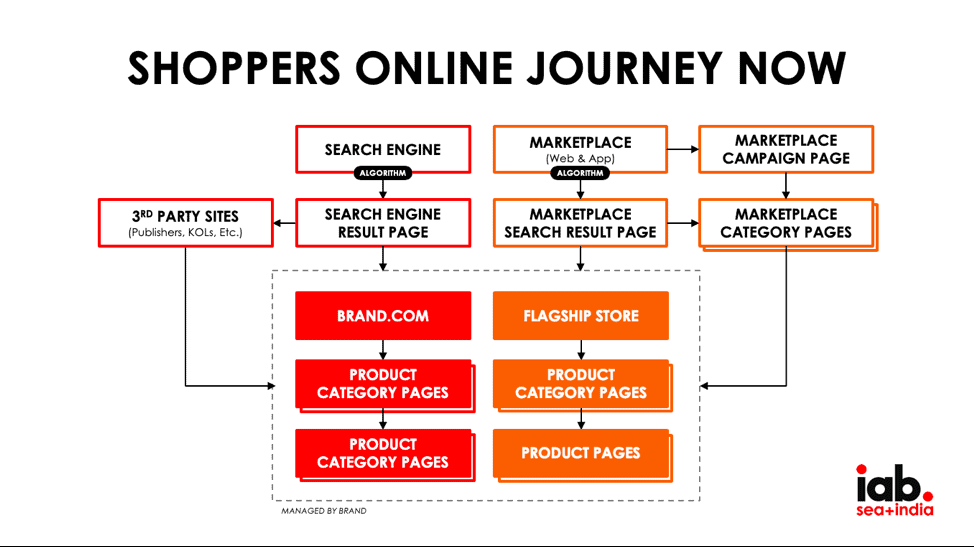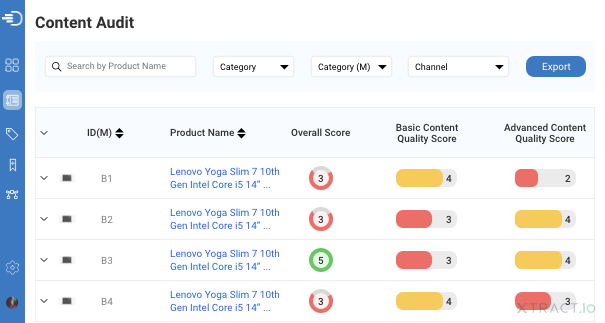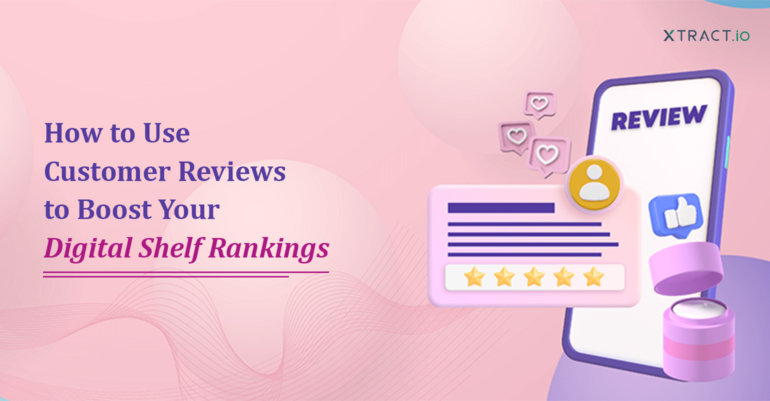In today’s digital marketplace, consumers increasingly discover and research products through online searches. If shoppers aren’t finding your products on the first page of results, you are likely to lose sales opportunities. Optimizing your product share of search (SOS) with search engine optimization (SEO) is vital for business growth. This blog will uncover tips for maximizing your product share of search using digital shelf analytics and optimization techniques.
The importance of SEO in increasing product share of search
Share of search (SOS) is the percentage of total search engine queries directed toward a specific brand, product, or website. It provides insight into how effectively your products appear for targeted keyword searches. A higher share of search signifies greater consumer interest and product search visibility for that brand versus rivals. SEO plays a significant role in influencing the share of search results.

With search engines being consumers’ primary tool to discover and purchase products online, businesses with a strong SEO strategy have a significant advantage. By tracking the share of search data over time on a digital shelf analytics tool, your brand can evaluate the effectiveness of strategies to improve organic discoverability and search rankings against competitors within the market.
Focusing SEO efforts on priority keywords that align with your products and brand name can significantly increase your share of search on Google and other marketplace search engines. This will lead to more brand visibility, traffic, and sales over time.
Key SEO strategies for maximizing product share of search
These key strategies will improve your visibility, help you target specific audiences, build credibility, and increase sales.
Conducting keyword research
Comprehensive keyword research establishes a strong foundation for a successful SEO strategy. When selecting keywords to target, you must carefully evaluate the relevance and monthly search volume to ensure you reach your ideal audience. Start by brainstorming and researching keywords and search queries directly related to your products, brand, and marketplace content.
Focus on terms and phrases that your target customers frequently use in search engines to find the right keywords for your business – these present high-potential opportunities. Examine each keyword’s average monthly searches and keyword difficulty scores to gauge competition and digital shelf optimization needs. Prioritize keywords with medium to high search volume and medium difficulty for your initial optimization efforts.

It’s also essential to continuously monitor emerging keywords and new search trends by analyzing digital shelf analytics tools for rising keyword optimization opportunities. Look for increasing search volumes around new keywords highlighting consumer interests and industry shifts. Optimize pages for these rising queries early on before your competition ramps up. This strategy boosts your visibility and website traffic from your target audience.
Identifying high-potential keywords relevant to products
Identifying high-potential keywords relevant to your products is essential in maximizing your product share of search. These keywords are the ones that have a significant search volume and are directly related to your offerings. Consider your products’ specific features, benefits, and uses.
Understand your target audience’s mindset and perspective to determine the optimal keywords and search queries they would use to find your products online. These keywords should accurately reflect the purpose and value of your offerings. Boost your product share of search and attract the right audience by targeting high-potential keywords relevant to your products. After compiling a list of relevant keyword opportunities, the next critical step is analyzing each term’s search volume and difficulty levels.
Prioritize keywords with high monthly search volumes – this indicates people are actively looking for your products using these keywords. Optimizing for the right balance of search volume and difficulty brings qualified visitors to your pages, boosting conversions.
Optimizing product titles, descriptions, and attributes
Once you have identified the high-potential keywords for your products, the next step is to optimize your product titles, descriptions, headers, URLs, and attributes with relevant keywords. You can improve your product share of search by concentrating on these elements. Start by crafting compelling product titles that include your targeted keywords.
Make sure the title accurately reflects the product and its main features. Keep it concise yet informative, as this is what potential customers will see in search engine results. In your product description, explain the benefits of the product in detail. Incorporate your keywords naturally throughout the product content, but avoid keyword stuffing. Develop content that captivates customers and motivates them to select your product.
In addition to titles and descriptions, optimize your product attributes as well. These include variables such as size, color, material, and any other relevant details. Use descriptive and keyword-rich terms to help search engines accurately understand and categorize your products. This will help you improve the product listing’s discoverability and attract more relevant traffic.
Structuring content for marketplace search engine visibility
Strategically optimizing your content to align with search engine algorithms boosts discoverability and visibility in relevant results. Follow search engine best practices like content organization, mobile optimization, site speed, and technical SEO. Prioritizing digital shelf optimization for customer searches improves your rankings and increases traffic from high-intent prospects.
A critical aspect of content structuring is the use of headings. By using headings hierarchy, such as H1, H2, and H3 tags, you can signal to search engines the importance and order of the information on your product pages. Including metadata, URLs, alt text, and content focused around targeted searches to help the search engine understand the context and result in better rankings.
Make your content scannable using bullet points, numbered lists, and other formatting techniques. These structures allow users and search bots to extract essential information rapidly. Scannable content presentation allows visitors and search engines to identify and comprehend your differentiators easily. This improves context and relevancy for product-specific queries.

Importance of high-quality images and multimedia
Visual content is pivotal for engaging customers and driving conversions. High-quality product images allow shoppers to inspect items closely and boost purchase confidence. Ensure your product pages feature numerous high-resolution photos shot from multiple angles. Optimize images with descriptive filenames and keyword-rich alt text so search engines understand what each picture depicts.
Compelling imagery builds trust, enhances site experience, and influences purchasing behavior. Well-optimized visual assets boost your rankings for related searches and help pages resonate with shoppers’ preferences. Craft alt text with concise keyword-rich descriptions to help search engines understand image content and display your products in image search.
Optimizing multimedia assets improves visibility across search results, enhances customer experience, and conveys valuable information to prospects. By prioritizing high-quality images and multimedia, you can improve the visual appeal of your products to differentiate them from competitors.

Bonus tip! User-generated reviews
User-generated reviews are another crucial factor that impacts product share of search. Positive reviews boost search rankings and referral traffic while building brand credibility and trust. Optimizing for branded keywords drives more searches to your site.
Your product reviews keep visitors on product pages longer, signaling the usefulness to search engines. You can influence organic search interest and performance by soliciting genuine positive reviews. Monitoring reviews’ impact on the share of search can inform effective review generation strategies.
Implementing SEO secrets for optimal product search
Implementing these SEO best practices is key to securing optimal product share of search, but tracking performance is equally important. DigiSense360 provides powerful digital shelf analytics with a comprehensive product share of a search dashboard to monitor your progress. With DigiSense360, brands can view the share of search data for top keywords, observe trends over time, and compare against competitors.

The interactive dashboard delivers actionable insights to identify opportunities to improve organic rankings, traffic, and conversions. Advanced features include tracking for top product pages and custom content scoreboards to help you understand the content performance. Robust filters allow brands to analyze the share of search by location, device, search engine, and more.
By leveraging DigiSense360’s enterprise-grade capabilities for monitoring the share of search, your ecommerce brand can optimize on-page content and publish engaging multimedia – ensuring their products stand out in competitive search results. The platform’s proprietary data and algorithms empower intelligent SEO decisions that boost visibility and search dominance.
With its comprehensive digital shelf optimization features, DigiSense360 gives brands the edge to maximize their share of search, outperform competitors, and reap the rewards of increased organic traffic and revenue growth. Get a free demo with us today!







